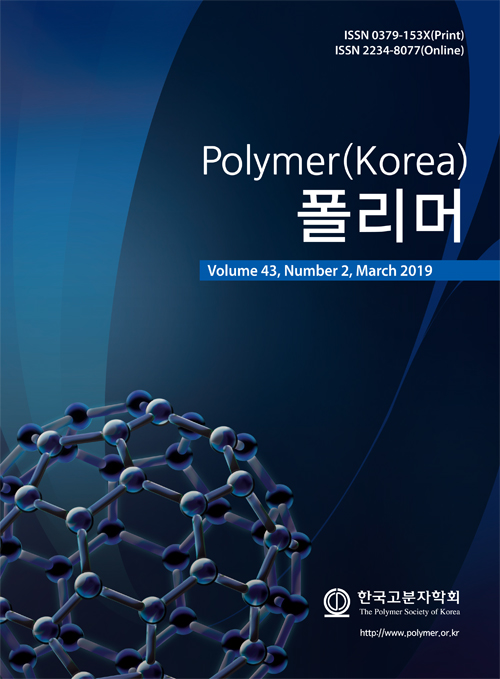- Synthesis of Sulfur-Citral Copolymers and Their Application to Cathode Materials for Lithium-Sulfur Batteries
Guk Yun Noh*,**, So Huyn Park*, Ji Mok Lee*,***, Byoung Gak Kim*,**, Jungdon Suk*,**, Dong-Gyun Kim*,†
 , and Yong Seok Kim*,**,†
, and Yong Seok Kim*,**,† 
*Advanced Materials Division, Korea Research Institute of Chemical Technology, 141 Gajeong-ro, Yuseong-gu, Daejeon 34114, Korea
**Chemical Convergence Materials and Processes, University of Science and Technology, 217 Gajeong-ro, Yuseong-gu, Daejeon 34114, Korea
***Department of Materials Science and Engineering, Korea University, 145 Anam-ro, Sungbuk-gu, Seoul 02841, Korea- 황-시트랄 공중합체의 합성 및 리튬-황 전지용 양극 소재로의 응용
노국윤*,** · 박소현* · 이지목*,*** · 김병각*,** · 석정돈*,** · 김동균*,†
 · 김용석*,**,†
· 김용석*,**,† 
*한국화학연구원 화학소재연구본부, **과학기술연합대학원대학교 KRICT 스쿨, ***고려대학교 신소재공학부
Lithium-sulfur batteries (LSBs) have been of particular interest over the last decade but the long-term problem of polysulfide elution that causes deterioration of cell performance remains a challenge. Herein, an effective cathode active material applicable to LSBs was prepared through the inverse vulcanization reaction of citral, a natural product. During the inverse vulcanization reaction, a sulfur-citral copolymer (SCPs) having a high sulfur content of 78-93% was prepared by controlling the equivalence ratio of elemental sulfur and citral. In particular, LSBs, in which a sulfur-citral copolymer having a sulfur content of 89% was applied as a cathode active material, were confirmed to have limited polysulfide elution, and thus showed excellent capacity retention. This is attributed to the large content of electrolyte-insoluble long polymer chains as well as low content of unreacted elemental sulfur presented in polymer chain.
리튬-황 전지는 지난 십여 년간 많은 관심 속에 연구되었지만, 장기적으로 전지 성능 저하를 야기하는 폴리 설파이드 용출 문제가 여전히 당면 과제로 남아있다. 본 논문에서는 천연물 유래인 시트랄에 역가황 반응을 통하여 리튬-황 전지에 적용 가능한 효과적인 양극 활 물질을 제조하였다. 역가황 반응 시, 원소 황과 시트랄의 당량비를 조절하여 78-93%의 높은 황 함유랑을 갖는 황-시트랄 공중합체를 합성하였다. 특히, 89%의 황 함유량을 갖는 황-시트랄 공중합체를 양극 활 물질로 적용한 리튬-황 전지는 폴리설파이드 용출이 제한됨을 확인하였고, 그에 따라 우수한 용량 유지율을 보였다. 이는 공중합체에 존재하는 미반응 원소 황이 적을뿐 아니라, 전해액에 불용성인 긴 폴리설파이드 사슬의 함량이 높기 때문이다.
Keywords: lithium-sulfur batteries, inverse vulcanization, elemental sulfur, citral
- Polymer(Korea) 폴리머
- Frequency : Bimonthly(odd)
ISSN 0379-153X(Print)
ISSN 2234-8077(Online)
Abbr. Polym. Korea - 2023 Impact Factor : 0.4
- Indexed in SCIE
 This Article
This Article
-
2019; 43(2): 282-288
Published online Mar 25, 2019
- 10.7317/pk.2019.43.2.282
- Received on Nov 29, 2018
- Revised on Dec 20, 2018
- Accepted on Dec 20, 2018
 Correspondence to
Correspondence to
- Dong-Gyun Kim* , and Yong Seok Kim*,**
-
*Advanced Materials Division, Korea Research Institute of Chemical Technology, 141 Gajeong-ro, Yuseong-gu, Daejeon 34114, Korea
**Chemical Convergence Materials and Processes, University of Science and Technology, 217 Gajeong-ro, Yuseong-gu, Daejeon 34114, Korea - E-mail: dgkim@krict.re.kr, yongskim@krict.re.kr








 Copyright(c) The Polymer Society of Korea. All right reserved.
Copyright(c) The Polymer Society of Korea. All right reserved.